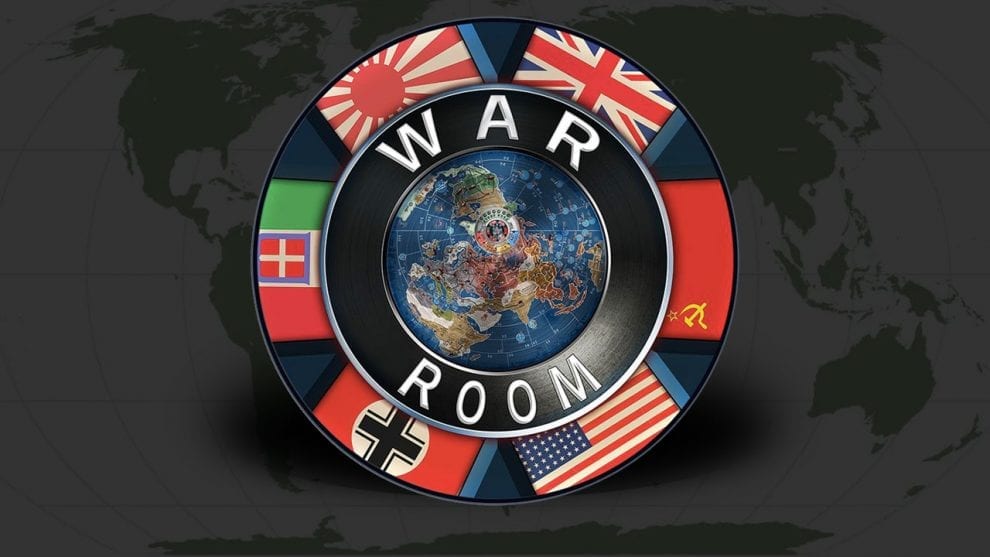War Room is an experience.
It’s a board game yes, but as a package it is so much more. It’s a social endeavour. It’s an all-day event. It’s plotting and planning with friends and acquaintances, poring over maps and comparing orders. It’s buying pizza for lunch, takeout wings for dinner, and having snacks on hand all day . It’s rolling buckets of dice and laughing at the absurd outcomes. It’s not the most strategic game of the Second World War that I’ve played, but it may be one of the grandest, the flashiest, and the most entertaining things I’ve managed to cram onto my table in a long, long time.
War Room, from the legendary designer of Axis and Allies, Larry Harris, is a grand strategic game of WWII combat for two to six players. Taking ample inspiration from Axis and Allies as well as Diplomacy, then mixing in some innovations in player engagement and a massive board chock full of components, War Room succeeds in blowing most of its similarly-sized competitors out of the proverbial chilly Atlantic Waters. It’s not a perfect experience, but the joy of getting to play a full game of War Room with a group of interested players is well worth any hiccups.
Entering the War Room
War Room starts players off with seven principal nations engaged in the hard fighting of the Second World War. The year appears to be 1942, and things are looking bad all over. Nazi Germany has captured most of continental Europe and are locked in a titanic struggle with The Soviet Union. Italy struggles to exert control over the Mediterranean and North Africa while Great Britain and her many colonies parry attacks in Egypt, the Atlantic, and in Southeast Asia. Japan is grinding down the stubborn resistance of the Republic of China, while the United States hurries to assist its allies, defend its island possessions, and prepare for a knockout across the Pacific. The Allies will secure victory by controlling Germany and Japan, while the Axis will win if they can control the capitals of two of three Allied nations, the Soviet Union, Great Britain, or the United States.
The massive game board starts with many armies, air groups, and fleets already in place, and each player is given their nation’s orders booklet, extra command tokens, resource tracker, and territory cards. On each turn, players will look at the cards they control, or the territories on the board themselves, and assess how many of the three principal resources—Oil, Iron, and OSR (Other Strategic Resources)—they will have that turn. Then each player simultaneously and secretly writes the orders for their units in the booklet and bids Oil for turn order. When everyone is finished, their orders are revealed and checked by an opponent, turn order is established, and armies start moving.

A great deal of the strategy of War Room shines in the order phase. Here allies are free to discuss their plans, their Oil bids, and their overall objectives. Each Nation is limited to nine orders a turn (six for Italy and China), and this restriction forces players to plan their attacks carefully. Crafty opponents will quickly figure out where they can feint and mislead, as there are never enough orders to allow every unit to end up where it needs to be. But this also hits upon one of War Room’s greatest features: with the exception of movement and combat resolution, every phase can be taken simultaneously. The overall reduction in player downtime is something that dramatically elevates War Room above its closest kin, Axis and Allies.
When it comes to figuring out turn order and moving, the order system again demonstrates its excellence. Units pin enemy units of the same size in place, preventing their movement. When a unit is given an order and it comes time to move it, it can only make the journey if the move is legal. Moves can be made illegal if the destination is too far to be reached, or if something has happened in a previous player’s movement to alter the board situation. If enemy units move into your territory, it can prevent your own movement. The struggle for turn order is very real when the difference between getting tanks into Leningrad is dependent on not being attacked and pinned first. The strategy continues to evolve in interesting ways too. Planning a naval movement, but the enemy might move along one or two pathways? Since orders only list the unit and their destination, there is some potential for covering alternate routes and therefore creating a more elastic defense. In short, the order system, as both a way to keep players involved, and as a strategic mind game within the wider scope of War Room, is excellent.

When opposing forces occupy the same territory, the space is marked with a token to indicate that a battle must be fought there. Battles see all the units in that territory moved to the battle board. The battle board lists every type of unit and the number of dice they can roll. The best feature about combat is stances. Every type of unit can be placed in different stances based on how the commanding player decides to use them. Perhaps Infantry should be on the offensive, giving them two dice per token. Perhaps they should be on the defensive, getting only one die but requiring two hits to remove. Perhaps a mix? This minor adjustment takes what could have been a mindless dice chucking combat system and gives it some interesting depth and tough decision making. The dice themselves are twelve-sided with different coloured faces based on the units they hit. There are four yellow faces for infantry and submarines, for example, but only one red face for bombers and battleships. If the type of unit rolled isn’t participating in the battle, it’s a miss. There are also black and white faces: blacks are wild, and whites can only be used to destroy damaged units. The interesting twist is that black and white faces only apply for the side that has the greater variety of unit types (or both if sides are equal). It serves as thematic encouragement to build combined arms forces and to reward the side that comes better equipped to a battle.
If units from both sides remain after all the dice have been tossed, the territory is marked as embattled, affecting its resource production and indicating that the battle will occur again on the next turn. This, of course, gives both sides time to funnel reinforcements into the battle. I was a little unhappy to see that retreat is not an option. Units, once committed, will basically remain in the territory until they either achieve victory or are utterly destroyed. There is the possibility to filter units out while observing the pinning rules, but it is often more expedient to push a battle in a given territory and go for the win.
Each nation must be careful about its casualties though, as they and the loss of territory build stress. Hit the stress threshold and your nation will sink to a lower level of efficiency. First this is a loss of some resources, but it quickly spirals into total collapse. It is not uncommon for games to be decided by the morale track and not the actual conquest of territories. When combat and morale are dealt with, nations again simultaneously buy new units that will be released near the end of the next round. I could go into greater detail about the nuances of War Room, like convoy raiding, trading with neutral nations, and managing civilian goods, but suffice to say that there is a bit of extra interesting detail that doesn’t overwhelm the core of the game.

How Long Will I Stay in the War Room?
War Room is a very long game, especially if you do it right and play with a full table of six players and the full campaign. War Room is still a long game if you do it any other way. There are four scenarios: the full game, a European War, a Pacific War, and the War on the Eastern Front between Nazi Germany and the Soviet Union. War Room is still fun at these smaller scales, but part of what makes it so special is the spectacle of a full room and the entire campaign. Some of the cracks in the system start to emerge when there’s a smaller player count. It’s by no means unfun at smaller counts, but there are other games that do the European War for two much better, like Worthington’s Struggle for Europe. The Eastern Front scenario especially, when there is no other concern around the globe, becomes a slugfest.
The point is that, unless you can see getting six players over for a day of gaming, War Room might be too large and too expensive to be worth the investment. I personally feel that, if I can get one or two full games in during a year, I’d consider the investment well worth it, but it is something that must be considered. The second edition will be coming in at around $200 USD, though you can get some impressive savings during the current Kickstarter. The game itself is also massive. The full board comes in at 42 inches in diameter, and there also needs to be room for the morale board, the battle board, and each player’s stuff.

There’s a Fancy Map Waiting in the War Room
Overall War Room has good physical components. The map itself is wonderful. The art is clear and the information contained on each space is easy to parse. Some of the spaces can be a little tight for how large the armies can get, but overall, I didn’t find it too difficult to maneuver. There are two reference boards with smaller maps printed on the back to aid order writing.
I got the sense that a great deal of effort went into streamlining the experience of playing the game. There are card holders to keep territories organized, though I wish they were a little more maneuverable as it feels like they may damage the cards over time. Each player has a peg board for noting resources and a box to contain all their tokens. The orders booklets are a little rough, and I wondered why the default wasn’t to include a dry erase board (a set is available online for extra cost). The Battle Board and the Morale board are also sturdy, and I only noticed a single misprint. The image for the battleship and carrier are flipped on the morale board, but since they both incur a cost of 20 casualty points, it has no practical effect.

It’s Time to Start a Fight in the War Room
Where War Room shines is in the grand, the explosive, the big group game. Outside of that environment, it is a solid wargame with a good bit of dice chucking and some innovative systems. It’s a joy to play, but I feel that joy is contingent on the environment that you and your friends can create for War Room. As an expression of the fun emergent storytelling and strategic planning that can grow out of such an experience, War Room is hands down the best game for it. It’s not as reserved or chess-like as Diplomacy, but it isn’t as mindless or long -winded as Axis and Allies. If the stars align and you can get a Saturday and five friends to dedicate to the game, War Room is an experience like no other.
8/10 War Room is an excellent big box wargame for six players. The cost, size, and optimal player count means that only the dedicated should proceed. But if the stars align, War Room is an unparalleled way to spend a day with friends.












Add Comment